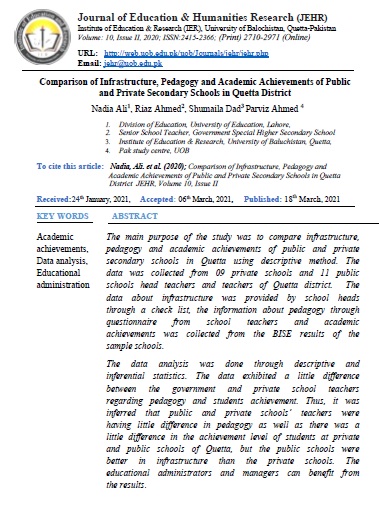Comparison of Infrastructure, Pedagogy and Academic Achievements of Public and Private Secondary Schools in Quetta District
Keywords:
Academic achievements, Data analysis, Educational administrationAbstract
This research was done by descriptive method and survey was performed at various secondary schools of District Quetta. All the government and private secondary schools of district Quetta were taken as population of the study. A Two Stage Sampling Technique was adopted in data analysis. In the first stage, there was a random selection of secondary schools of Quetta District on public and private basis. In the second stage the data of the set goals including the infrastructure, pedagogy, and the academic achievements of these randomly selected public and private schools were collected through questionnaires. For the data collection tool, a check list method was used in which standard infrastructure facilities were mentioned such as the school building, number of class rooms, play grounds, canteen, tuck-shop, furniture, multi-media, projector etc. each of infrastructure facility was checked on the basis of its availability.
For academic achievements’ assessment, the data collection tool was the last four years’ result of the Balochistan Board of Intermediate and Secondary Education (BBISE) Quetta, whereas the pedagogical evaluation was done through questionnaire that were filled from the students of the under studied schools. The data analysis was done through descriptive and inferential statistics. The data exhibited a significant difference between the government and private school teachers regarding the understanding of pedagogy. Thus, it was inferred that government schools’ teachers were more focused on the understanding of pedagogy than the private school teachers.
It was concluded that both the government and private schools of Quetta city were performing well. However, there is a lot of room for improvement for both types of schools to make the educational standard higher. The educational administrators and managers can benefit from the results.
References
Berkowitz R, Moore H, Astor RA, Benbenishty R. A Research Synthesis of the Associations Between Socioeconomic Background, Inequality, School Climate, and Academic Achievement. Review of Educational Research. 2017;87(2):425-469.
Prayitno B A, D Corebima, H Susilo, S Zubaidah, M Ramli 2017 Closing The science process skills gap between students with high and low level academic achievement. Journal of Baltic Science Education, 16(2): p 266-277.
Paul Black & Dylan Wiliam (2018).
Classroom assessment and pedagogy, Assessment in Education: Principles, Policy &Practice, 25:6, 551-575.
Jumanovich, T.A., Eshboevna, T.D. (2019). Features of basic methodological approaches in pedagogy. European Journal of Research and Reflection in Educational Sciences. 7(12).
Herwan, H., Aswandi, A. & Chiar, M. (2018). The role of school committee in supporting the fulfillment of education facilities and infrastructure. Journal of Education, Teaching and Learning, 3(2), 282-287.
Iqbal, M. (2012). Public versus Private Secondary Schools: A Qualitative Comparison. Journal of Research & Reflections in Education. 6 (1), 50-62.
Celia Álvarez-Bueno, Caterina Pesce, Iván Cavero-Redondo, Mairena Sánchez- López, Miriam Garrido-Miguel and Vicente Martínez-Vizcaíno. (2017). Academic Achievement and Physical Activity: A Meta-analysis. Pediatrics, e20171498.
Begum, H.,&Sadruddin, M. M. (2013).A Study Of Administrative Issues In Secondary Schools of Quetta.Social Sciences and Humanities,4(3), 297–306.
Hammersley,M. (2000). Taking sides in social research. London: Routledge.
Khan, A. (2012). Instructional Management of A Private and A Government Secondary School Principal In Northern Pakistan, International Journal of Educational Development, 32( 1), 120–131.
Lyimo, N.S., Too, J.K and Kipng’etich, K. J. (2017). Perception of teachers on availability of instructional materials and physical facilities in secondary schools of Arusha District, Tanzania. International Journal of Educational Policy Research and Review Vol.4 (5), pp. 103-112.
Okafor, A.I. (2014). Investigating relationships between availability of laboratory facilities and academic performance in biology among senior secondary school students in Zamfara state, Nigeria. Usmanu Danfodiyo University, Sokoto State, Nigeria.
Neog, M., & Sinha. P. (2017). A comparative study on the scope of ICT intervention of government & private schools of Nagaon District. dlkkhsou.inflibnet.ac.in.
Papanastasiou, E. C., &Zembylas, M. (2005). Job Satisfaction Variance Among Public And Private Kindergarten School Teachers In Cyprus.International Journal of Educational Research, 43(3), 147–167.
Peterson, P. E., & Llaudet, E. (2006). On the public-private school achievement debate. Taubman, 306.
Suryadarma, D. Suryahadi, A. Sumarto. S. and Rogers F. H. (2006). Improving Student Performance In Public Primary Schools In Developing Countries: Evidence From Indonesia. Education Economics, 14(4), 401–429.
U.S. Department of Education (2012). Student achievement in private schools. National Assessment to Educational Progress, NCES 2006.
Vally, H., McMichael, C., Doherty, C., Li, X., Guevarra, G., & Tobias, P. (2019). The Impact of a School-Based Water, Sanitation and Hygiene Intervention on Knowledge, Practices, and Diarrhoea Rates in the Philippines. International journal of environmental research and public health, 16(21), 4056.




